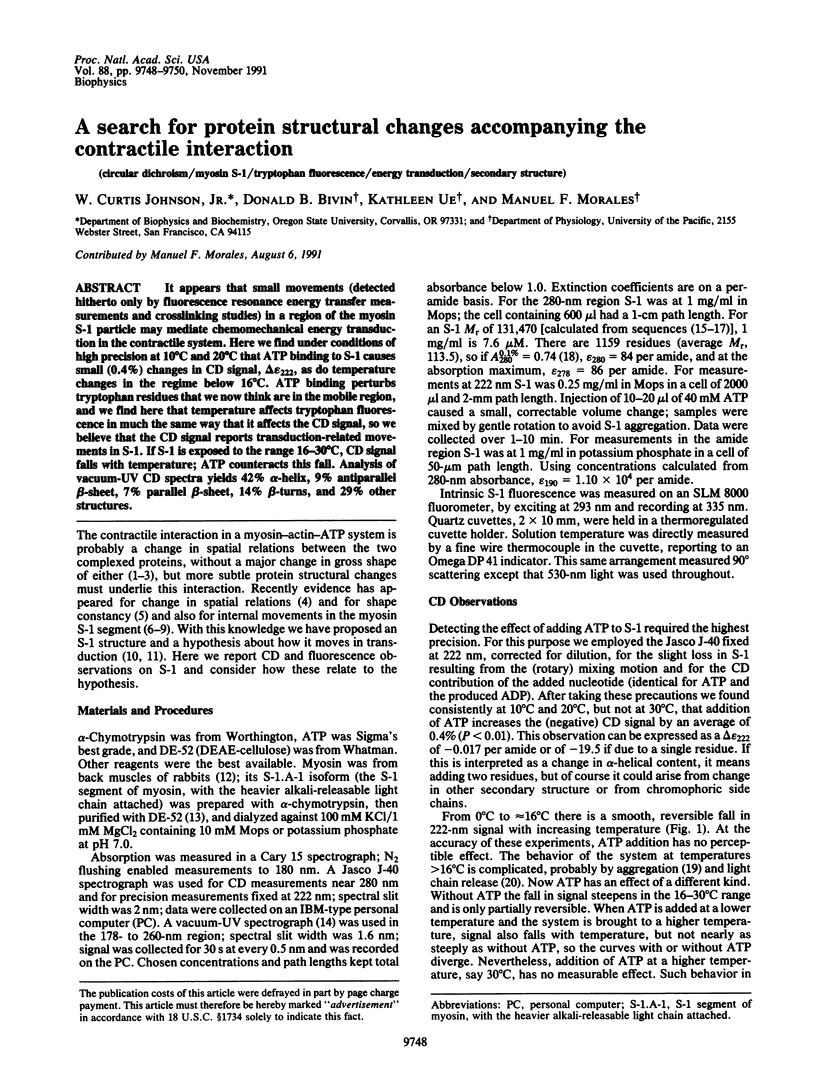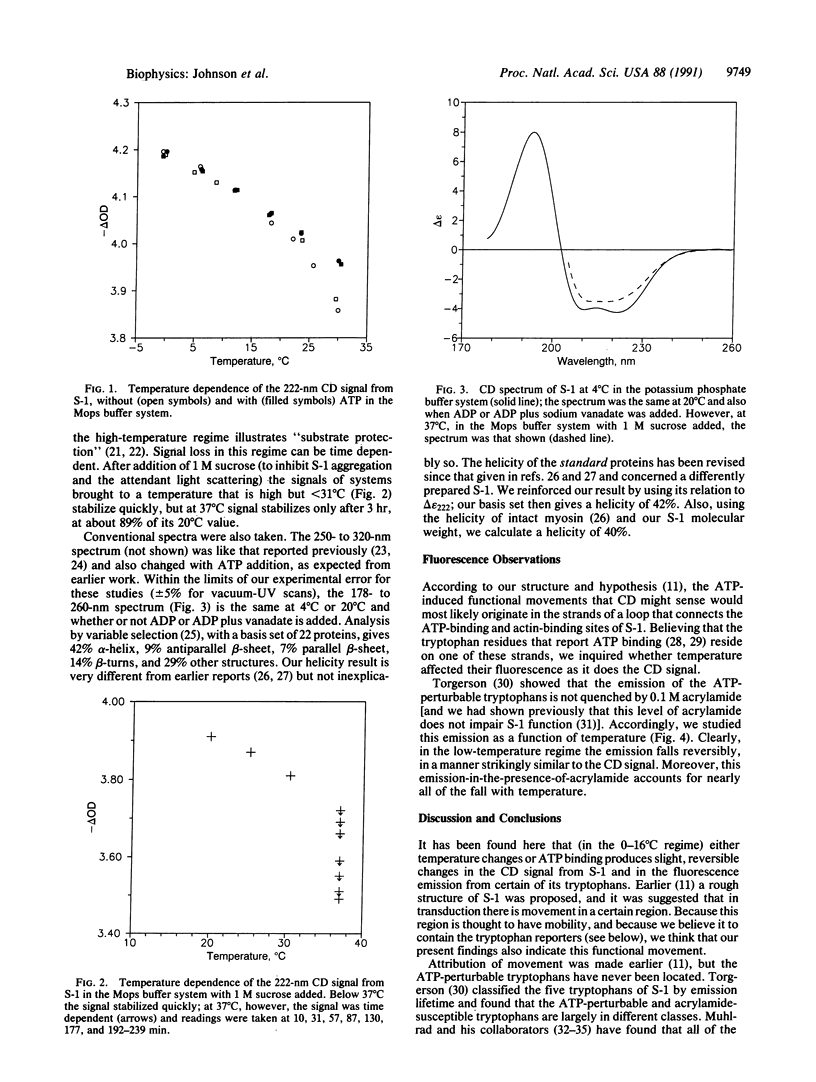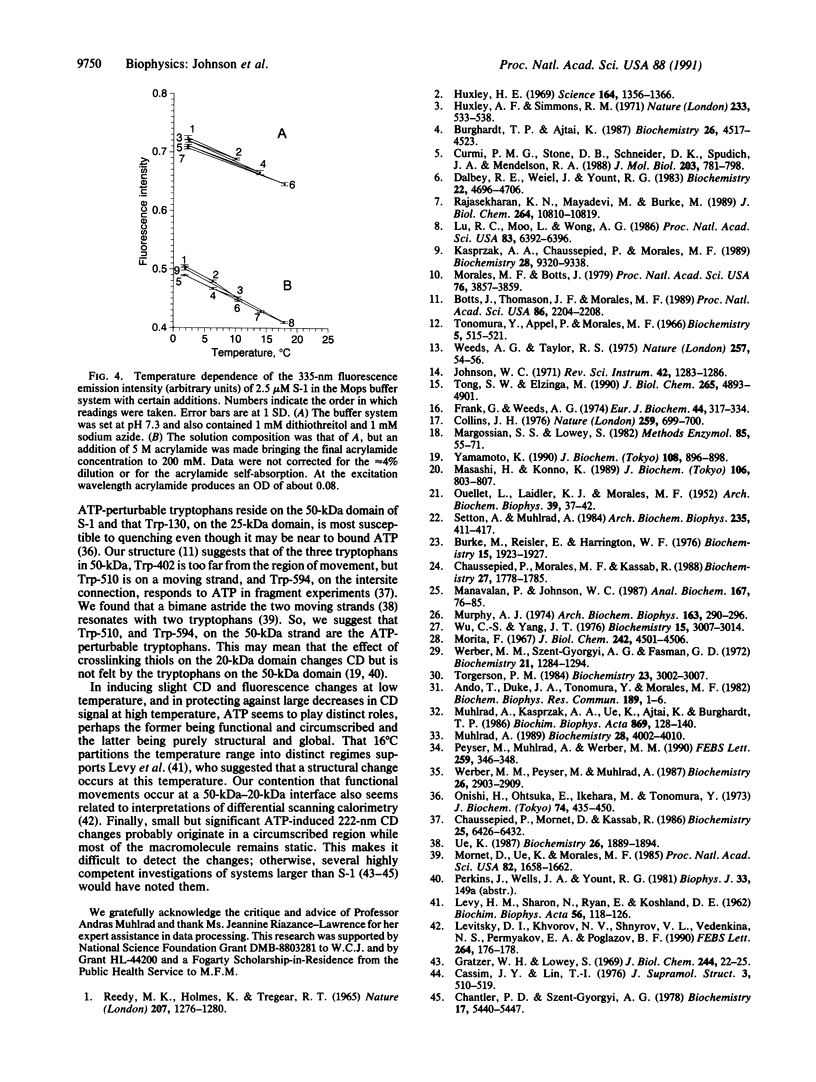Abstract
It appears that small movements (detected hitherto only by fluorescence resonance energy transfer measurements and crosslinking studies) in a region of the myosin S-1 particle may mediate chemomechanical energy transduction in the contractile system. Here we find under conditions of high precision at 10 degrees C and 20 degrees C that ATP binding to S-1 causes small (0.4%) changes in CD signal, delta epsilon 222, as do temperature changes in the regime below 16 degrees C. ATP binding perturbs tryptophan residues that we now think are in the mobile region, and we find here that temperature affects tryptophan fluorescence in much the same way that it affects the CD signal, so we believe that the CD signal reports transduction-related movements in S-1. If S-1 is exposed to the range 16-30 degrees C, CD signal falls with temperature; ATP counteracts this fall. Analysis of vacuum-UV CD spectra yields 42% alpha-helix, 9% antiparallel beta-sheet, 7% parallel beta-sheet, 14% beta-turns, and 29% other structures.
Full text
PDF


Selected References
These references are in PubMed. This may not be the complete list of references from this article.
- Ajtai K., Burghardt T. P. Probe studies of the MgADP state of muscle cross-bridges: microscopic and wavelength-dependent fluorescence polarization from 1,5-IAEDANS-labeled myosin subfragment 1 decorating muscle fibers. Biochemistry. 1987 Jul 14;26(14):4517–4523. doi: 10.1021/bi00388a052. [DOI] [PubMed] [Google Scholar]
- Ando T., Duke J. A., Tonomura Y., Morales M. F. Spectroscopic isolation of ES complexes of myosin subfragment-1 ATPase by fluorescence quenching. Biochem Biophys Res Commun. 1982 Nov 16;109(1):1–6. doi: 10.1016/0006-291x(82)91557-1. [DOI] [PubMed] [Google Scholar]
- Botts J., Thomason J. F., Morales M. F. On the origin and transmission of force in actomyosin subfragment 1. Proc Natl Acad Sci U S A. 1989 Apr;86(7):2204–2208. doi: 10.1073/pnas.86.7.2204. [DOI] [PMC free article] [PubMed] [Google Scholar]
- Burke M., Reisler F., Harrington W. F. Effect of bridging the two essential thiols of myosin on its spectral and actin-binding properties. Biochemistry. 1976 May 4;15(9):1923–1927. doi: 10.1021/bi00654a020. [DOI] [PubMed] [Google Scholar]
- Cassim J. Y., Lin T. I. Does myosin-substrate interaction in vitro result in a delocalized conformation change? J Supramol Struct. 1975;3(5-6):510–519. doi: 10.1002/jss.400030510. [DOI] [PubMed] [Google Scholar]
- Chantler P. D., Szent-Györgyi A. G. Spectroscopic studies on invertebrate myosins and light chains. Biochemistry. 1978 Dec 12;17(25):5440–5448. doi: 10.1021/bi00618a018. [DOI] [PubMed] [Google Scholar]
- Chaussepied P., Morales M. F., Kassab R. The myosin SH2-50-kilodalton fragment cross-link: location and consequences. Biochemistry. 1988 Mar 8;27(5):1778–1785. doi: 10.1021/bi00405a059. [DOI] [PubMed] [Google Scholar]
- Chaussepied P., Mornet D., Kassab R. Identification of polyphosphate recognition sites communicating with actin sites on the skeletal myosin subfragment 1 heavy chain. Biochemistry. 1986 Oct 21;25(21):6426–6432. doi: 10.1021/bi00369a013. [DOI] [PubMed] [Google Scholar]
- Collins J. H. Homology of myosin DTNB light chain with alkali light chains, troponin C and parvalbumin. Nature. 1976 Feb 26;259(5545):699–700. doi: 10.1038/259699a0. [DOI] [PubMed] [Google Scholar]
- Curmi P. M., Stone D. B., Schneider D. K., Spudich J. A., Mendelson R. A. Comparison of the structure of myosin subfragment 1 bound to actin and free in solution. A neutron scattering study using actin made "invisible" by deuteration. J Mol Biol. 1988 Oct 5;203(3):781–798. doi: 10.1016/0022-2836(88)90209-4. [DOI] [PubMed] [Google Scholar]
- Dalbey R. E., Weiel J., Yount R. G. Förster energy transfer measurements of thiol 1 to thiol 2 distances in myosin subfragment 1. Biochemistry. 1983 Sep 27;22(20):4696–4706. doi: 10.1021/bi00289a014. [DOI] [PubMed] [Google Scholar]
- Frank G., Weeds A. G. The amino-acid sequence of the alkali light chains of rabbit skeletal-muscle myosin. Eur J Biochem. 1974 May 15;44(2):317–334. doi: 10.1111/j.1432-1033.1974.tb03489.x. [DOI] [PubMed] [Google Scholar]
- Gratzer W. B., Lowey S. Effect of substrate on the conformation of myosin. J Biol Chem. 1969 Jan 10;244(1):22–25. [PubMed] [Google Scholar]
- Hamai M., Konno K. Thermal stability as a probe of S-1 structure. J Biochem. 1989 Nov;106(5):803–807. doi: 10.1093/oxfordjournals.jbchem.a122934. [DOI] [PubMed] [Google Scholar]
- Huxley A. F., Simmons R. M. Proposed mechanism of force generation in striated muscle. Nature. 1971 Oct 22;233(5321):533–538. doi: 10.1038/233533a0. [DOI] [PubMed] [Google Scholar]
- Huxley H. E. The mechanism of muscular contraction. Science. 1969 Jun 20;164(3886):1356–1365. doi: 10.1126/science.164.3886.1356. [DOI] [PubMed] [Google Scholar]
- Johnson W. C., Jr A circular dichroism spectrometer for the vacuum ultraviolet. Rev Sci Instrum. 1971 Sep;42(9):1283–1286. doi: 10.1063/1.1685367. [DOI] [PubMed] [Google Scholar]
- LEVY H. M., SHARON N., RYAN E. M., KOSHLAND D. E., Jr Effect of temperature on the rate of hydrolysis of adenosine triphosphate and inosine triphosphate by myosin with and without modifiers. Evidence for a change in protein conformation. Biochim Biophys Acta. 1962 Jan 1;56:118–126. doi: 10.1016/0006-3002(62)90532-2. [DOI] [PubMed] [Google Scholar]
- Levitsky D. I., Khvorov N. V., Shnyrov V. L., Vedenkina N. S., Permyakov E. A., Poglazov B. F. Domain structure of myosin subfragment-1. Selective denaturation of the 50 kDa segment. FEBS Lett. 1990 May 21;264(2):176–178. doi: 10.1016/0014-5793(90)80242-b. [DOI] [PubMed] [Google Scholar]
- Lu R. C., Moo L., Wong A. G. Both the 25-kDa and 50-kDa domains in myosin subfragment 1 are close to the reactive thiols. Proc Natl Acad Sci U S A. 1986 Sep;83(17):6392–6396. doi: 10.1073/pnas.83.17.6392. [DOI] [PMC free article] [PubMed] [Google Scholar]
- Manavalan P., Johnson W. C., Jr Variable selection method improves the prediction of protein secondary structure from circular dichroism spectra. Anal Biochem. 1987 Nov 15;167(1):76–85. doi: 10.1016/0003-2697(87)90135-7. [DOI] [PubMed] [Google Scholar]
- Margossian S. S., Lowey S. Preparation of myosin and its subfragments from rabbit skeletal muscle. Methods Enzymol. 1982;85(Pt B):55–71. doi: 10.1016/0076-6879(82)85009-x. [DOI] [PubMed] [Google Scholar]
- Morales M. F., Botts J. On the molecular basis for chemomechanical energy transduction in muscle. Proc Natl Acad Sci U S A. 1979 Aug;76(8):3857–3859. doi: 10.1073/pnas.76.8.3857. [DOI] [PMC free article] [PubMed] [Google Scholar]
- Morita F. Interaction of heavy meromyosin with substrate. I. Difference in ultraviolet absorption spectrum between heavy meromyosin and its Michaelis-Menten complex. J Biol Chem. 1967 Oct 10;242(19):4501–4506. [PubMed] [Google Scholar]
- Mornet D., Ue K., Morales M. F. Stabilization of a primary loop in myosin subfragment 1 with a fluorescent crosslinker. Proc Natl Acad Sci U S A. 1985 Mar;82(6):1658–1662. doi: 10.1073/pnas.82.6.1658. [DOI] [PMC free article] [PubMed] [Google Scholar]
- Muhlrad A. Isolation and characterization of the N-terminal 23-kilodalton fragment of myosin subfragment 1. Biochemistry. 1989 May 2;28(9):4002–4010. doi: 10.1021/bi00435a056. [DOI] [PubMed] [Google Scholar]
- Muhlrad A., Kasprzak A. A., Ue K., Ajtai K., Burghardt T. P. Characterization of the isolated 20 kDa and 50 kDa fragments of the myosin head. Biochim Biophys Acta. 1986 Jan 30;869(2):128–140. doi: 10.1016/0167-4838(86)90287-6. [DOI] [PubMed] [Google Scholar]
- Murphy A. J. Circular dichroism of the adenine and 6-mercaptopurine nucleotide complexes of heavy meromyosin. Arch Biochem Biophys. 1974 Jul;163(1):290–296. doi: 10.1016/0003-9861(74)90479-2. [DOI] [PubMed] [Google Scholar]
- OUELLET L., LAIDLER K. J., MORALES M. F. Molecular kinetics of muscle adenosine triphosphatase. Arch Biochem Biophys. 1952 Jul;39(1):37–50. doi: 10.1016/0003-9861(52)90258-0. [DOI] [PubMed] [Google Scholar]
- Onishi H., Otsuka E., Ikehara M., Tonomura Y. Energy transfer from tryptophan residues to a fluorescent ATP analog, 1,N6-ethenoadenosine triphosphate, bound to H-meromyosin. J Biochem. 1973 Sep;74(3):435–450. doi: 10.1093/oxfordjournals.jbchem.a130263. [DOI] [PubMed] [Google Scholar]
- Peyser Y. M., Muhlrad A., Werber M. M. Tryptophan-130 is the most reactive tryptophan residue in rabbit skeletal myosin subfragment-1. FEBS Lett. 1990 Jan 1;259(2):346–348. doi: 10.1016/0014-5793(90)80044-j. [DOI] [PubMed] [Google Scholar]
- Rajasekharan K. N., Mayadevi M., Burke M. Studies of ligand-induced conformational perturbations in myosin subfragment 1. An examination of the environment about the SH2 and SH1 thiols using a photoprobe. J Biol Chem. 1989 Jun 25;264(18):10810–10819. [PubMed] [Google Scholar]
- Reedy M. K., Holmes K. C., Tregear R. T. Induced changes in orientation of the cross-bridges of glycerinated insect flight muscle. Nature. 1965 Sep 18;207(5003):1276–1280. doi: 10.1038/2071276a0. [DOI] [PubMed] [Google Scholar]
- Setton A., Muhlrad A. Effect of mild heat treatment on the ATPase activity and proteolytic sensitivity of myosin subfragment-1. Arch Biochem Biophys. 1984 Dec;235(2):411–417. doi: 10.1016/0003-9861(84)90214-5. [DOI] [PubMed] [Google Scholar]
- Tong S. W., Elzinga M. Amino acid sequence of rabbit skeletal muscle myosin. 50-kDa fragment of the heavy chain. J Biol Chem. 1990 Mar 25;265(9):4893–4901. [PubMed] [Google Scholar]
- Tonomura Y., Appel P., Morales M. On the molecular weight of myosin. II. Biochemistry. 1966 Feb;5(2):515–521. doi: 10.1021/bi00866a017. [DOI] [PubMed] [Google Scholar]
- Torgerson P. M. Tryptophan emission from myosin subfragment 1: acrylamide and nucleotide effect monitored by decay-associated spectra. Biochemistry. 1984 Jun 19;23(13):3002–3007. doi: 10.1021/bi00308a024. [DOI] [PubMed] [Google Scholar]
- Ue K. Intramolecular cross-linking of myosin subfragment 1 with bimane. Biochemistry. 1987 Apr 7;26(7):1889–1894. doi: 10.1021/bi00381a016. [DOI] [PubMed] [Google Scholar]
- Weeds A. G., Taylor R. S. Separation of subfragment-1 isoenzymes from rabbit skeletal muscle myosin. Nature. 1975 Sep 4;257(5521):54–56. doi: 10.1038/257054a0. [DOI] [PubMed] [Google Scholar]
- Werber M. M., Peyser Y. M., Muhlrad A. Modification of myosin subfragment 1 tryptophans by dimethyl(2-hydroxy-5-nitrobenzyl)sulfonium bromide. Biochemistry. 1987 May 19;26(10):2903–2909. doi: 10.1021/bi00384a035. [DOI] [PubMed] [Google Scholar]
- Wu C. S., Yang J. T. Reexamination of the conformation of muscle proteins by optical activity. Biochemistry. 1976 Jul 13;15(14):3007–3014. doi: 10.1021/bi00659a011. [DOI] [PubMed] [Google Scholar]
- Yamamoto K. Electron microscopy of thermal aggregation of myosin. J Biochem. 1990 Dec;108(6):896–898. doi: 10.1093/oxfordjournals.jbchem.a123309. [DOI] [PubMed] [Google Scholar]


